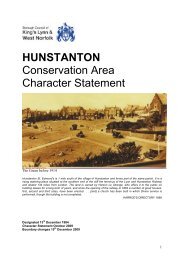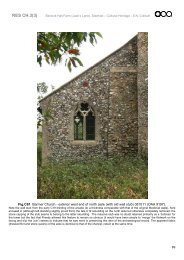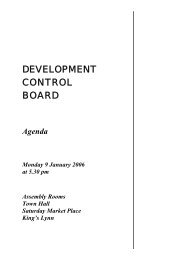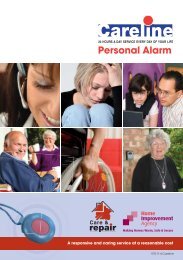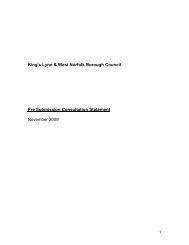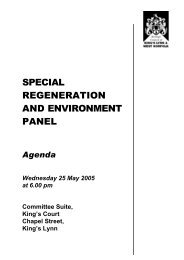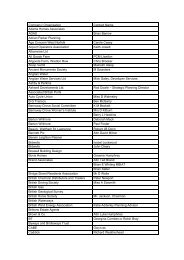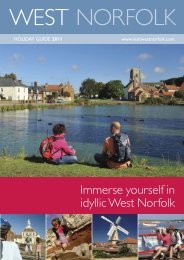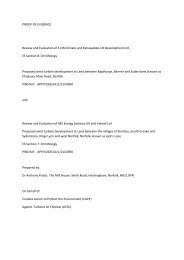11/00713/F - Borough Council of King's Lynn & West Norfolk
11/00713/F - Borough Council of King's Lynn & West Norfolk
11/00713/F - Borough Council of King's Lynn & West Norfolk
Create successful ePaper yourself
Turn your PDF publications into a flip-book with our unique Google optimized e-Paper software.
Generally speaking residents <strong>of</strong> HMOs would be expected to have a low level <strong>of</strong> car<br />
ownership. However, planning cannot control the age, occupation or lifestyle <strong>of</strong> persons<br />
occupying a property. It is likely that the occupants may be students <strong>of</strong> the nearby college<br />
which is within walking distance, thereby having no need for a car, but this cannot be<br />
guaranteed. It has been reported by neighbours, however, that students in the area<br />
generally do have cars but don’t use them for college and keep them parked near their place<br />
<strong>of</strong> residence.<br />
Conversely, it may be argued that premises may lawfully be used for the accommodation <strong>of</strong><br />
a large family or 6+ individuals living together as a family and that such occupation may give<br />
rise to even greater parking requirements than a multiple occupation use.<br />
In terms <strong>of</strong> parking provision the government has relaxed the need for minimum standards<br />
for parking. PPG13 states that local authorities "should revise their parking standards to<br />
allow for significantly lower levels <strong>of</strong> <strong>of</strong>f-street parking provision, particularly for<br />
developments in locations, such as town centres, where services are readily accessible by<br />
walking, cycling or public transport”.<br />
In this case the site is close to the college, within walking distance <strong>of</strong> King’s <strong>Lynn</strong> town<br />
centre, railway station, buses and shops. The site also provides for three <strong>of</strong>f-street parking<br />
spaces, so contributes someway to the local parking provision. Given that permitted<br />
development rights allow for the use <strong>of</strong> the building as a HMO for up to 6 residents and the<br />
fact that the current use <strong>of</strong> the property could house a large family with equal demands for<br />
car parking facilities it is not considered that the demands for parking generated by this<br />
proposal (1 additional bedroom over permitted development) would be significantly greater<br />
or lead to significant highway safety concerns.<br />
Residential Amenity, noise and anti-social behaviour<br />
Third party objection has been made to the general noise and disturbance which may be<br />
generated by the proposed change <strong>of</strong> use. Concern has also been raised regarding the<br />
playing <strong>of</strong> loud music, groups <strong>of</strong> occupants congregating late at night and the general<br />
demise <strong>of</strong> the area and increase in crime and vandalism. Concern has been raised regarding<br />
the compatibility <strong>of</strong> the use in a family orientated residential area.<br />
However, these issues could already occur with use <strong>of</strong> the site by a large family or smaller<br />
HMO arrangement which would not require planning permission. In this case it is not<br />
considered the proposal would lead to such an increase in general noise and disturbance to<br />
warrant the refusal <strong>of</strong> planning permission.<br />
The Community Safety & Neighbourhood Nuisance Officer has not objected to the proposal<br />
but requests that due to the potential amount <strong>of</strong> people using the property, the applicant<br />
should show that they are going to provide additional insulation to protect the neighbouring<br />
residents. However, as this application would result in only one additional bedroom over the<br />
permitted development limits it is not considered necessary to impose such a condition.<br />
Impact on Conservation Area<br />
PPS5 - Planning for the Historic Environment states that local planning authorities should<br />
take into account the desirability <strong>of</strong> new development making a positive contribution to the<br />
character and local distinctiveness <strong>of</strong> the historic environment. The site itself is not within the<br />
Conservation Area but it can be seen from the opposite side <strong>of</strong> the road where the<br />
Conservation Area boundary runs.<br />
<strong>11</strong>/00732/CU Development Control Board<br />
25 July 20<strong>11</strong><br />
127



